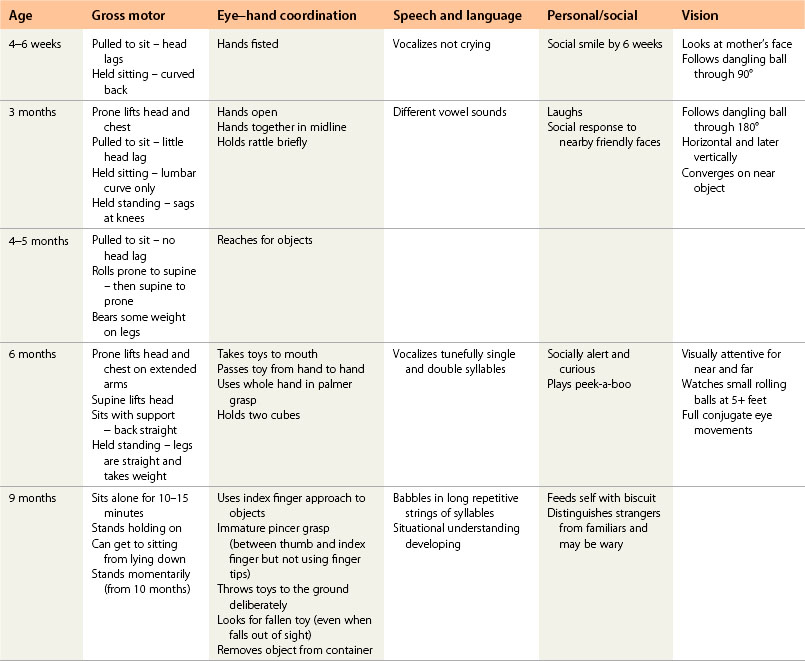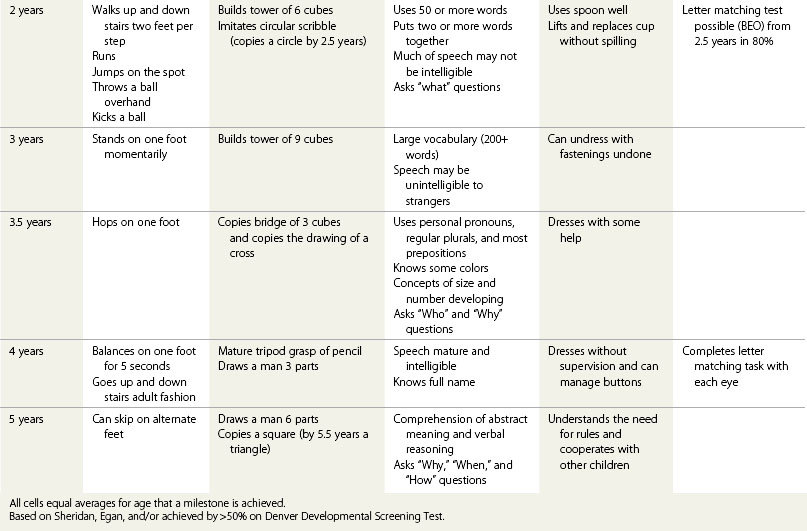Chapter 122 How should an ophthalmologist tell if a child’s development is normal?
Risk factors
• Pregnancy factors: infection (especially cytomegalovirus, toxoplasmosis, and rubella), consumption of drugs or alcohol, smoking, hypertension, and exposure to irradiation.
• Health of the fetus: poor growth, reduced fetal movements, or reduced or excessive amniotic fluid.
• Delivery: the need for resuscitation and signs of significant encephalopathy in the infant, such as significant drowsiness, poor feeding, and seizures soon after birth suggest that damage was sustained around the time of birth. If no such signs are present, the birth is unlikely to have a causal relationship to later developmental problems. A difficult delivery accounts for few subsequent neurological and developmental problems, although parents often worry about difficulties that they experienced.1
• Premature birth (<37 weeks’ gestation): gestational age is strongly correlated with the risk of subsequent developmental problems. When considering whether a premature child is reaching developmental milestones it is appropriate to take account of gestational age up to the age of 2 years.
• Serious infection of the central nervous system: meningitis or encephalitis especially in the early weeks or months of life.
• Jaundice in the first days of life: prolonged and severe jaundice (>340 µmol/liter).
• Conditions of the eye that are known to be associated with developmental problems.
• As there are a number of conditions that affect both vision and hearing, always enquire about hearing concerns. Delay in speech development should always lead to referral for assessment of hearing.
Developmental milestones in the fully sighted child
Next, consider whether a child is reaching their expected developmental milestones.
Some key milestones are described in Table 122.1. These are based on normative data from Sheridan,2 Egan,3 and the revised Denver developmental screening test.4 This table shows the average age at which the majority of children achieve particular milestones.
Parents will usually remember the age their child reached major developmental milestones − independent sitting and walking, the development of first words, and when their child was speaking clearly.5
Development is generally considered under the following domains:
When should delay in milestones cause concern?
Box 122.1 provides a list of potential developmental warning signs that will help the clinician to recognize when to be concerned about delay in a particular milestone and therefore request further assessment.
Box 122.1
Developmental warning signs
| At any age | Excessive hypotonia (floppiness) or hypertonia (stiffness) |
| Marked asymmetry of posture, movements, or muscle tone | |
| Persistent hand fisting | |
| Persistent tremor, clonus, jerky movements | |
| Tendency to push head back and arch body | |
| Parental concern about hearing or vision | |
| 0−3 months | Feeding problems – weak suck |
| 4 weeks | Not fixing on mother’s face |
| No response to sound | |
| 3 months | Not smiling responsively |
| Not fixing and following | |
| Inability to hold toy placed in hand | |
| 4 months |






